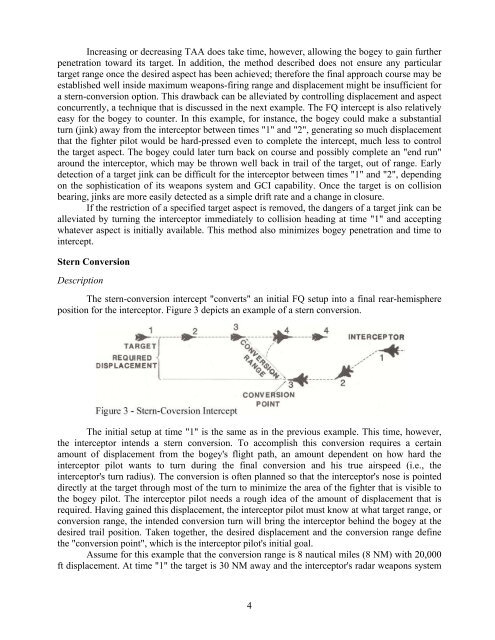Tactical Intercepts.pdf - e-HAF
Tactical Intercepts.pdf - e-HAF
Tactical Intercepts.pdf - e-HAF
You also want an ePaper? Increase the reach of your titles
YUMPU automatically turns print PDFs into web optimized ePapers that Google loves.
Increasing or decreasing TAA does take time, however, allowing the bogey to gain further<br />
penetration toward its target. In addition, the method described does not ensure any particular<br />
target range once the desired aspect has been achieved; therefore the final approach course may be<br />
established well inside maximum weapons-firing range and displacement might be insufficient for<br />
a stern-conversion option. This drawback can be alleviated by controlling displacement and aspect<br />
concurrently, a technique that is discussed in the next example. The FQ intercept is also relatively<br />
easy for the bogey to counter. In this example, for instance, the bogey could make a substantial<br />
turn (jink) away from the interceptor between times "1" and "2", generating so much displacement<br />
that the fighter pilot would be hard-pressed even to complete the intercept, much less to control<br />
the target aspect. The bogey could later turn back on course and possibly complete an "end run"<br />
around the interceptor, which may be thrown well back in trail of the target, out of range. Early<br />
detection of a target jink can be difficult for the interceptor between times "1" and "2", depending<br />
on the sophistication of its weapons system and GCI capability. Once the target is on collision<br />
bearing, jinks are more easily detected as a simple drift rate and a change in closure.<br />
If the restriction of a specified target aspect is removed, the dangers of a target jink can be<br />
alleviated by turning the interceptor immediately to collision heading at time "1" and accepting<br />
whatever aspect is initially available. This method also minimizes bogey penetration and time to<br />
intercept.<br />
Stern Conversion<br />
Description<br />
The stern-conversion intercept "converts" an initial FQ setup into a final rear-hemisphere<br />
position for the interceptor. Figure 3 depicts an example of a stern conversion.<br />
The initial setup at time "1" is the same as in the previous example. This time, however,<br />
the interceptor intends a stern conversion. To accomplish this conversion requires a certain<br />
amount of displacement from the bogey's flight path, an amount dependent on how hard the<br />
interceptor pilot wants to turn during the final conversion and his true airspeed (i.e., the<br />
interceptor's turn radius). The conversion is often planned so that the interceptor's nose is pointed<br />
directly at the target through most of the turn to minimize the area of the fighter that is visible to<br />
the bogey pilot. The interceptor pilot needs a rough idea of the amount of displacement that is<br />
required. Having gained this displacement, the interceptor pilot must know at what target range, or<br />
conversion range, the intended conversion turn will bring the interceptor behind the bogey at the<br />
desired trail position. Taken together, the desired displacement and the conversion range define<br />
the "conversion point", which is the interceptor pilot's initial goal.<br />
Assume for this example that the conversion range is 8 nautical miles (8 NM) with 20,000<br />
ft displacement. At time "1" the target is 30 NM away and the interceptor's radar weapons system<br />
4
















